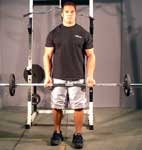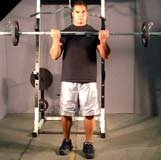Your mother may have taught you that "cheaters never win," but in the case of bodybuilding, mom was wrong!
The cheating technique, when done properly and at the right time, can help maximize your workout intensity, get you out of that rut, and give you the gains you've been looking for. This is especially great if you workout alone and don't have a spotter to help you out with forced reps.
The Cheating Concept
The principle of this concept is simple: after the agonists have been completely exhausted by using strict control and proper form, use non-prime movers to assist in lifting a heavy weight for several more repetitions. This allows you to up the intensity and volume in order to make better gains in muscle size.
Here's An Example
You're on your third set of heavy barbell curls. You've increased the weight on each set and now you're aiming for 8 reps. Using awesome form and weight control, you bang out 4 reps, no problem. Then on rep five, you get halfway up and screech to a grinding halt. What do you do?


 Click To Enlarge.
Click To Enlarge. Barbell Curl
You don't want to end the set—you've got three more reps! This is when you implement the cheating principle. You probably won't even have to try; it comes naturally when the primary muscle - in this case, biceps - is exhausted.
Allow yourself to bend your knees a little and use your hips to curl the weight up, then use slow and controlled form to lower the weight back to the start position. Repeat until you've completed your final 3-5 reps.
To Cheat Or Not To Cheat?
It's best to cheat on your final set of an exercise, or at most your final two sets. If you're cheating on the very first set, you're probably starting the exercise with too heavy of a weight. Remember, in the case of barbell curls you're still trying to fatigue the biceps to failure, so you don't want to start cheating before the biceps have had enough time under tension to become completely exhausted.
You also shouldn't cheat on more than the last five reps of a set. Again, if you're cheating too early in the set, the weight is too heavy and you won't be working the prime mover enough before resorting to the cheat method.
Picture those guys in the gym that try to curl with a 45-pound plate on each side, and their form is so bad it looks like they're gonna throw their back out at any second. That's who you don't want to be!
So bruise your ego if you have to, reduce the weight and perform the exercise with good form and control until you feel the agonist truly fatigued, then add in just a few cheat reps to get that extra burn, up the intensity and up the volume.
Complimentary Methods
Cheating goes well with three of its buddies:
- Rest-Pause
- Negatives
- Drop Sets
1. Rest-Pause
In the rest-pause method, once you've reached failure, you temporarily stop the set, take a few deep breaths, and bang out another 1-3 reps to end the set.
2. Negatives
Negatives are performed with an extra long tempo on the eccentric (lowering) portion of the rep.
3. Drop Sets
With drop sets, you reach failure, drop the weight by 5-15 lbs. and knock out another 3-12 reps.
You're Only Limited By Your Creativity
All three of these methods work great with the cheating method. Simply perform your first set of continuous reps to failure, perform several cheat reps, then perform a few rest-pause reps, negative reps, or a drop set.
You're only limited by your creativity here. It's a great idea to read as much as you can on different variations and methods of traditional lifting, so you have a bag of tricks to pull from during your workouts. There doesn't have to be rhyme or reason to your training when you use these methods. That is, it doesn't have to be a formal training method.
The best bodybuilders in the world train with intuition. Once you've learned these concepts, you can pull from them by intuition at any given moment in your workout. It keeps things fun and creative, ensures you're training with crazy intensity, and keeps you on your way to building your ultimate physique.
Final Pointers
Cheating is an instinctive response. You're not going to have to consciously do it. As your body fatigues, it will automatically begin recruiting other muscles to assist in the lift. Your job is to actually fight against your body's instinct to cheat. So, instead of ending the set when you begin performing poorly, aim to keep that strict form under the pressure and exhaustion of fatigue.
This is a fairly advanced training method. You should only utilize it once you've developed proper neuromuscular efficiency and "mind-muscle" connection in order to consciously contract the given muscle at any given time.
A good rule of thumb when determining if you're overdoing it with weight is to gauge range of motion and fatigue of the prime mover.
- First, if you're performing half or partial reps, the weight is too heavy.
- Second (and sometimes in combination with the first), if you can't feel the primary muscle working and exhausting during the lift, you still haven't developed the proprioception and neuromuscular efficiency necessary to participate effectively in this advanced technique.
